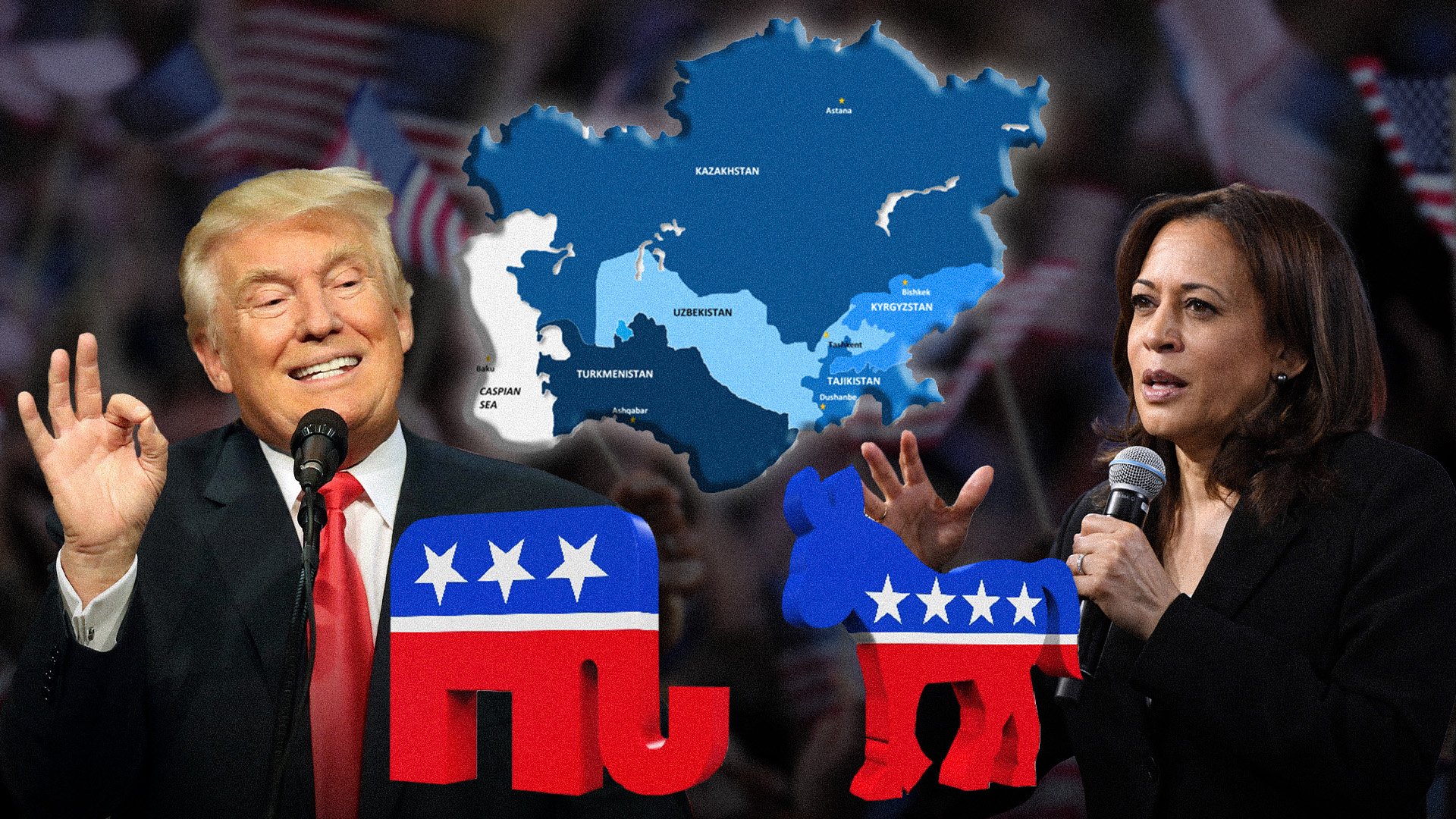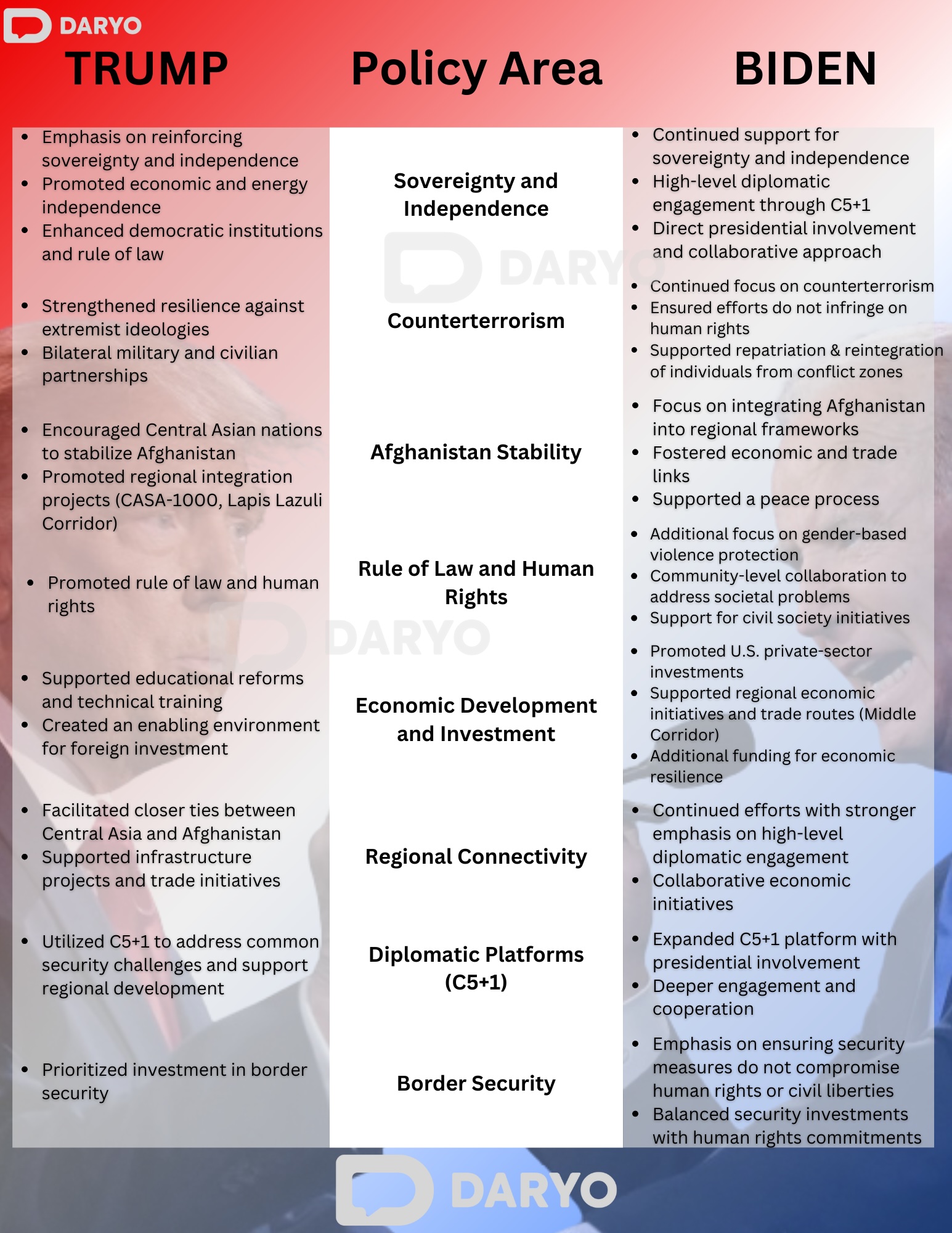Recently, President Joe Biden decided to withdraw from the 2024 presidential race amid increasing calls from within his party questioning his capability to defeat Donald Trump after the previous debates. Following his withdrawal, Biden endorsed Vice President Kamala Harris as the Democratic nominee. Harris has been actively campaigning, highlighting her readiness and experience, while drawing attention to the differences in values between the Democratic and Republican tickets. Despite concerns, many Democrats have shown strong support for Harris, viewing her as a capable leader who can continue Biden's policy legacy and address key issues like reproductive rights and economic inequality.

The political landscape in the U.S. can influence its foreign policy in Central Asia. A notable difference is that under Trump, a new U.S. strategy for Central Asia was adopted, while under Biden, the State Department developed individual strategies for each country in the region. Additionally, the Biden administration focuses on cooperation in rare earth metals and regional integration, whereas the Trump administration emphasized counterterrorism and closer ties between Central Asia and Afghanistan.
In general, the analysis shows that the U.S. policy in Central Asia, regardless of the party winning the elections, has recently been quite harmonious and complementary. When analyzing the policies of the Trump and Biden administrations in Central Asia, one can aobserve how the initiatives of one administration smoothly transitioned into new initiatives of the subsequent administration. Regardless of whether Harris or Trump wins the upcoming elections, the defining factors in their foreign policy in Central Asia might be the U.S. relationships with Russia, China, and Iran, as well as other global trends that could increase the attractiveness of Central Asia, such as gaining access to the extraction of rare earth metals.
In terms of security, Central Asian countries have increasingly come under U.S. scrutiny, although the U.S. remains less influential in the region compared to China, Russia, and the EU. An analysis of mentions of Central Asia in U.S. strategies from 2000 using R programming shows an increase compared to mentions of Eastern Balkan countries. Over time, it seems there is no difference between Republicans and Democrats in mentioning Central Asia, but the recent trend of increased mentions along with different approaches by the Trump and Biden administrations may indicate otherwise. Additionally, U.S. Senator Steve Daines announced the formation of the Senate Central Asia Caucus, aimed at strengthening U.S. relationships with Central Asian allies, enhancing trade and investment, and supporting regional stability and security. The Caucus, launched in collaboration with Senator Gary Peters, seeks to address challenges posed by the influence of Russia, China, and Iran. Key focus areas include improving trade relations, boosting agricultural development, addressing human trafficking and migration, and increasing national security partnerships.
Shifting Priorities: U.S. Policy in Central Asia from Trump to Biden

Recently, it seems that the U.S. is gradually reassessing its policy towards Central Asian countries or has shifted its priorities in the region. Kazakhstani political analyst Andrei Chebotarev notes that during Donald Trump's presidency, the U.S. Central Asia Strategy for 2019-2025 was adopted. Chebotarev adds that Joe Biden and his team essentially failed this strategy in terms of fostering closer ties between Central Asian countries and Afghanistan, leaving the former Afghan government without adequate support against the Taliban in 2021. This example highlights how the priorities of different U.S. administrations in Central Asia change, prompting reflections on U.S.-Central Asia relations amid active changes in the election race.
However, comparing the policies implemented by Donald Trump and Joe Biden shows that there is a certain continuity in the region's policy. As the chart of Central Asia mentions in U.S. national security strategies indicates, the region's mentions dropped to zero during Obama's strategies, while an increase was observed under Trump and Biden. Considering that the U.S. has not always had heightened interest in Central Asia and given the fact that no U.S. leader has ever visited the region despite the presence of NATO military bases there in the past, it can be assumed that both leaders initiated new policies in the region, such as the adoption of the U.S. Central Asia Strategy by the Trump administration.
Biden's and Trump's: some common foundation for foreign policy in Central Asia?
The Biden administration's policy towards Central Asia reflects some shifts from the previous strategy outlined during Trump's administration, though it builds on some foundational elements.
The Trump administration's strategy for Central Asia, detailed in the 2019-2025 document, focused on reinforcing the sovereignty and independence of the Central Asian nations. This included promoting economic and energy independence and enhancing democratic institutions and the rule of law. The strategy emphasized consistent U.S. engagement in economic, energy, security, democracy, and governance issues to help these countries function as cooperative partners. Biden continues to support sovereignty and independence, but with a particular emphasis on high-level diplomatic engagement through the C5+1 format and direct presidential involvement. The administration underscores a collaborative approach with regional leaders to ensure stability and self-reliance.
On counterterrorism, the Trump administration aimed to strengthen resilience against extremist ideologies and prevent the region from becoming a haven for terrorist organizations through bilateral military and civilian partnerships. The Biden administration maintains the focus on counterterrorism while also highlighting the importance of ensuring that these efforts do not infringe on human rights. The administration supports the repatriation and reintegration of individuals from conflict zones, striving to balance security and civil liberties.
In terms of supporting stability in Afghanistan, the Trump strategy encouraged Central Asian nations to play active roles in stabilizing Afghanistan, developing economic ties, and promoting regional integration projects like CASA-1000 and the Lapis Lazuli Corridor. Biden's policy maintains this focus but adds an emphasis on integrating Afghanistan into regional economic and security frameworks, encouraging Central Asian states to foster economic and trade links with Afghanistan, and supporting a peace process.
Both administrations have prioritized the promotion of rule of law and human rights, but the Biden administration has placed additional focus on gender-based violence protection and community-level collaboration to address societal problems. This includes supporting civil society initiatives and ensuring governance reforms are inclusive and transparent.
Economic development and U.S. investment were key aspects of the Trump strategy, which aimed to create an enabling environment for foreign investment by supporting educational reforms and technical training. The Biden administration enhances this focus by actively promoting U.S. private-sector investments and supporting regional economic initiatives, providing additional funding for economic resilience, and emphasizing trade routes like the Middle Corridor to enhance connectivity and economic integration.
Regarding regional connectivity, both administrations have facilitated closer ties between Central Asian countries and Afghanistan across various sectors, supporting infrastructure projects and trade initiatives to improve regional connectivity and economic integration. Biden's administration continues these efforts with a stronger emphasis on high-level diplomatic engagement and collaborative economic initiatives.
The C5+1 diplomatic platform has been a crucial element in both strategies, with the Trump administration utilizing it to address common security challenges and support regional development. The Biden administration expands on this platform by involving the President in C5+1 meetings, symbolizing a commitment to deeper engagement and cooperation.
Investment in border security has been a priority for both administrations, but Biden places additional emphasis on ensuring these measures do not compromise human rights or civil liberties. The administration seeks to balance security investments with human rights commitments.
Overall, the Biden administration's policy in Central Asia builds upon the foundations laid by the Trump administration but introduces significant shifts in engagement and emphasis. Higher-level engagement, a balanced approach to security and human rights, a greater focus on economic initiatives and trade, and continued support for governance and civil society characterize Biden's comprehensive approach to ensuring stability and prosperity in Central Asia while advancing U.S. interests and maintaining a balance between security, economic development, and human rights.
Future Implications for U.S. Policy in Central Asia
As the 2024 U.S. elections approach, the potential outcomes could significantly shape U.S. policy towards Central Asia. With Vice President Kamala Harris campaigning to continue President Biden's policy legacy, and Donald Trump advocating for a return to his previous strategies, the future direction of U.S.-Central Asia relations remains pivotal.
Harris's Potential Policies:
If Kamala Harris wins the presidency, it is likely that the current strategies will persist and even deepen. The Harris administration would probably maintain a strong focus on high-level diplomatic engagement, particularly through platforms like the C5+1. Emphasizing human rights, economic cooperation, and regional connectivity, Harris would likely continue to foster collaboration in rare earth metals and integration initiatives, ensuring that security measures respect civil liberties. Her administration might also continue to support Afghanistan’s stability through regional partnerships, while promoting economic resilience and private-sector investments in Central Asia.
As Andrew Gundal, a journalist and geopolitical and human rights analyst specializing in Central Asia, the Caucasus and China, points out, the main flaw in Kamala Harris' resume when she was selected four years ago was a lack of foreign policy experience. Therefore, given that she has only gained that experience in foreign policy over the past four years, we can expect the same line to continue if she is elected. Gundal also believes that there are two paths she could take regarding Central Asia: she could make the mistake of ignoring the region completely, as other key players and conflicts would divert her attention away from the Stans.
Trump's Potential Policies:
On the other hand, a Trump victory would likely bring a shift back to the policies of his previous administration. This could involve a renewed focus on counterterrorism and a closer relationship with Afghanistan. Trump's approach might emphasize strong, bilateral military and civilian partnerships to counter extremist threats. While maintaining support for sovereignty and independence, his administration might reduce emphasis on human rights in favor of more pragmatic, security-centered engagements. Trump's policies could also pivot back to more aggressive economic stances, potentially affecting trade relations and regional stability.
Despite these differences, the overall trend indicates a continuity of U.S. engagement in Central Asia, driven by both strategic interests and global geopolitical dynamics. The increasing attention to Central Asia in U.S. strategies highlights the region's growing importance. Whether through the promotion of democratic institutions and human rights or through pragmatic security and economic measures, U.S. policy will likely continue to adapt to the evolving landscape.
Conclusion: Driving factors of the US interests in Central Asia
As the U.S. navigates its foreign policy in Central Asia amid the upcoming elections, the fundamental objectives of promoting sovereignty, security, and economic development are likely to remain. The approaches may vary between a Harris or Trump administration, but the strategic importance of Central Asia in U.S. foreign policy is set to continue. The region's role in global geopolitics, particularly in relation to Russia, China, and Iran, will be a defining factor in shaping U.S. actions and strategies moving forward. Another factor is also gaining access to the strategic resources of Central Asian countries because of China's growing interest in them as well. The U.S. is actively promoting various innovative solutions for Central Asian countries to gain access to mining or exploration of rare earth metals. For example, Kazakhstan's Tau-Ken Samruk, in partnership with the U.S. Department of State and the National Geological Survey (UGQ), will explore prospective areas in the Kyzylorda and East Kazakhstan regions of Kazakhstan.
Written by: Eldaniz Gusseinov
Eldaniz Gusseinov, is a Non-Resident Research Fellow at Haydar Aliyev Center for Eurasian Studies of the Ibn Haldun University, Istanbul.
Follow Daryo's official Instagram and Twitter pages to keep current on world news.
Comments (0)